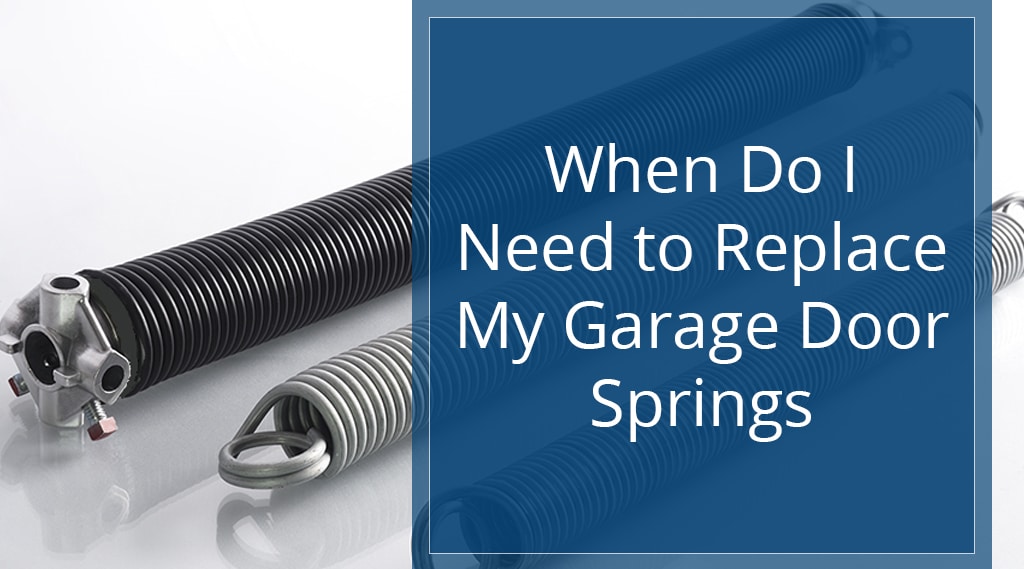
When Do I Need to Replace My Garage Door Springs?

No matter which type of springs your door has, one thing is certain— all springs eventually need to be replaced. Practicing proper maintenance will keep them in good condition and help you get the most life out of them as possible but you shouldn’t extend them to the point of danger. You may be asking yourself, “Well then when do I need to replace my garage door springs?” Read on to learn how to determine if it’s time to replace your springs.
What Type of Garage Door Springs Do I Have?
There are two types of garage door springs, torsion springs, and extension springs. Garage doors need springs because they counteract the force of gravity on the door. The springs make it easier to lift the door manually and by an electric motor. In fact, residential openers don’t have enough power to lift the door without springs. The door opener controls the door’s movement but the springs lift and balance the weight as it moves up and down.
Identifying Torsion Springs
Identifying torsion springs from extension springs is easy. If your door has torsion springs they’ll be mounted horizontally above the garage door opening. Most garage doors have two torsion springs, heavier doors can have more.
Torsion springs are tightly wound coils that power the lift of the door by winding and unwinding. The spring releases tension when the door is opened and tightens when the door is closed. Torsion springs are thicker than extension springs. The springs must be matched specifically to the weight of the door, the heavier the door the thicker the spring.
There are two types of torsion springs— exposed springs that are wound around a steel shaft and torsion barrel springs which are contained within a barrel.
Over time, the repeated opening and closing of the door wear out the spring. Weakened and damaged springs cannot provide the appropriate lifting power needed to open or close the door in a controlled or balanced manner. Torsion springs typically last about 15,000 to 20,000 cycles before they need to be replaced.
Identifying Extension Springs
Extension springs are mounted above the garage door tracks to the sides of the door and connected to the bottom of the door by a system of cables and pulleys. Doors with extension springs have at least two springs, one on either side of the door, but they can have more if the door is heavier.
When the door is closed the springs are extended. This is when the springs are most dangerous because they hold energy as they are stretched out. As the door opens the spring releases energy and returns to its original shape.
There are three types of extension springs— open looped, double looped, and clip ends. Open looped springs are the easiest to change out, double looped springs with stronger ends, and clip end springs have closed loops at the end with attached double-sided clips. Clip end springs are the most durable because less stress is placed on the spring.
Extension springs typically don’t last as long as torsion springs because they are constantly left in an extended position which subjects them to more wear and tear. Extension springs are usually good for about 10,000 cycles.
How to Check and Identify Worn Springs
How to Check the Condition of Torsion Springs
Begin by looking for red flags in torsion springs:
- The spring is stretched out when the door is closed. If the spring is stretched out it means there is no mechanical energy stored in the spring, it won’t have the strength to lift your door.
- There’s a gap in the spring. Sometimes when the spring reaches the end of its life span, it snaps and leaves a visible gap where the break is.
You can test the condition of your torsion springs by following the steps below:
- Close the garage door and pull the emergency release.
- Lift the door manually to waist height, make sure nothing is below the door (watch your feet!), then release the door. If it begins to drift down the springs are beginning to give. If it falls quickly then they’ve lost their power.
How to Check the Condition of Extension Springs
While there isn’t a test for extension springs one clear sign that extension springs are failing is gaps between the coils. Extension springs should stretch equally between coils, noticeable differences in space between the coils are a sign of failure and a need for replacement.
General Signs of Wear on Garage Door Springs
Check the garage door’s appearance and functionality. The signs below indicate worn-out torsion springs:
- A bad spring causes the door to be crooked or to jerk when it moves down the tracks.
- The door opens just a little then closes.
- Rust or corrosion.
- The door falls harshly when closing.
- Popping or screeching noises when the door is in motion.
- The door won’t open.
- The cables attached to the spring are loose.
If you notice any of the problems we’ve mentioned above, it’s time to call a professional for an inspection. They’ll provide you with a clear diagnosis of the condition of your door system and offer the necessary solution to get your door operating safely and efficiently again.
Replacing Worn Garage Door Springs
Replace worn garage door springs, they cannot be repaired. Old springs can never be restored to their original condition, do not attempt to repair or re-use them. Contact a professional or experienced garage door repair person to replace your garage door springs. Replacing springs can be extremely dangerous and it’s best left to someone with experience in safely removing and installing garage door springs.
Call Heritage Garage Door for Spring Replacement
If you suspect that your garage door springs have reached the end of their life span contact our team to schedule an appointment. Our technicians can inspect your door and identify any additional problems that could be causing your springs to wear out faster. We’ll find a solution to any garage door problem.
Heritage Garage Door operates in Southern California.


